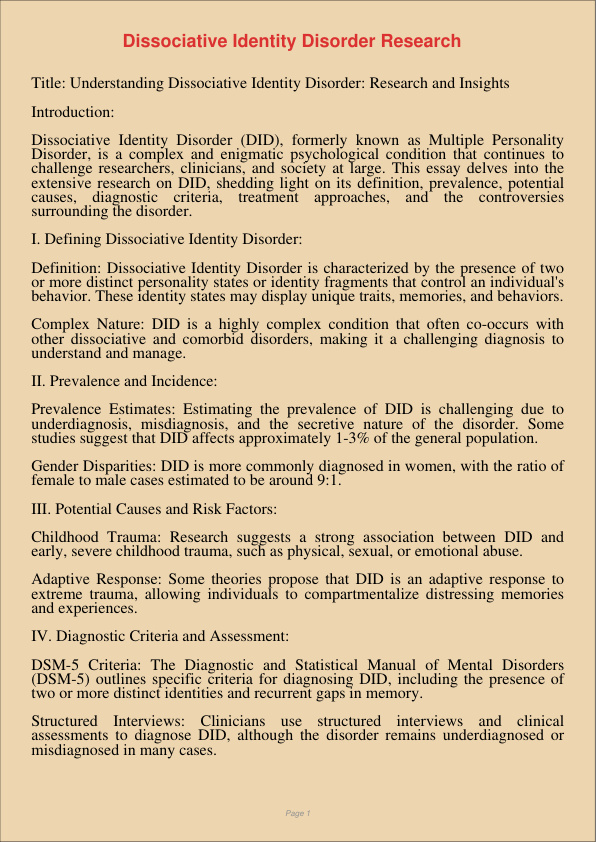Dissociative Identity Disorder Research
Jan 12, 2024
dissociative identity disorder research
Journalism & Communication
Engineering and Construction
Title: Understanding Dissociative Identity Disorder: Research and Insights
Introduction:
Dissociative Identity Disorder (DID), formerly known as Multiple Personality Disorder, is a complex and enigmatic psychological condition that continues to challenge researchers, clinicians, and society at large. This essay delves into the extensive research on DID, shedding light on its definition, prevalence, potential causes, diagnostic criteria, treatment approaches, and the controversies surrounding the disorder.
I. Defining Dissociative Identity Disorder:
Definition: Dissociative Identity Disorder is characterized by the presence of two or more distinct personality states or identity fragments that control an individual’s behavior. These identity states may display unique traits, memories, and behaviors.
Complex Nature: DID is a highly complex condition that often co-occurs with other dissociative and comorbid disorders, making it a challenging diagnosis to understand and manage.
II. Prevalence and Incidence:
Prevalence Estimates: Estimating the prevalence of DID is challenging due to underdiagnosis, misdiagnosis, and the secretive nature of the disorder. Some studies suggest that DID affects approximately 1-3% of the general population.
Gender Disparities: DID is more commonly diagnosed in women, with the ratio of female to male cases estimated to be around 9:1.
III. Potential Causes and Risk Factors:
Childhood Trauma: Research suggests a strong association between DID and early, severe childhood trauma, such as physical, sexual, or emotional abuse.
Adaptive Response: Some theories propose that DID is an adaptive response to extreme trauma, allowing individuals to compartmentalize distressing memories and experiences.
IV. Diagnostic Criteria and Assessment:
DSM-5 Criteria: The Diagnostic and Statistical Manual of Mental Disorders (DSM-5) outlines specific criteria for diagnosing DID, including the presence of two or more distinct identities and recurrent gaps in memory.
Structured Interviews: Clinicians use structured interviews and clinical assessments to diagnose DID, although the disorder remains underdiagnosed or misdiagnosed in many cases.
V. Treatment Approaches:
Psychotherapy: The primary treatment for DID is psychotherapy, particularly techniques like Dialectical Behavior Therapy (DBT), Cognitive Behavioral Therapy (CBT), and Eye Movement Desensitization and Reprocessing (EMDR).
Integration of Identities: Therapy aims to help individuals integrate their identity states, reduce amnesia, and develop healthier coping mechanisms.
Medication: Medication may be used to treat comorbid conditions like depression, anxiety, or mood disorders that often accompany DID.
VI. Controversies Surrounding DID:
Controversial Origins: Some critics argue that DID is a controversial diagnosis and may be a product of suggestibility, therapist influence, or media portrayals.
Cultural and Historical Perspectives: The understanding of DID varies across cultures and has evolved over time, influencing the diagnosis and treatment of the disorder.
Conclusion:
Dissociative Identity Disorder remains a subject of ongoing research, debate, and clinical practice. While the etiology of DID is still not fully understood, the link between severe childhood trauma and the development of distinct identity states is widely acknowledged. The diagnostic criteria, assessment, and treatment approaches have evolved over time, but the disorder continues to be challenging to diagnose and treat. As research and awareness of DID continue to grow, a more comprehensive understanding of the condition and more effective treatments may emerge, improving the lives of those affected by this complex disorder.
